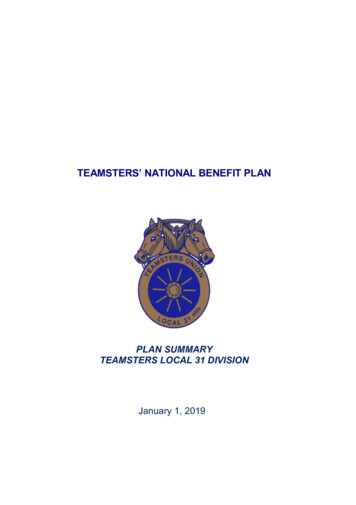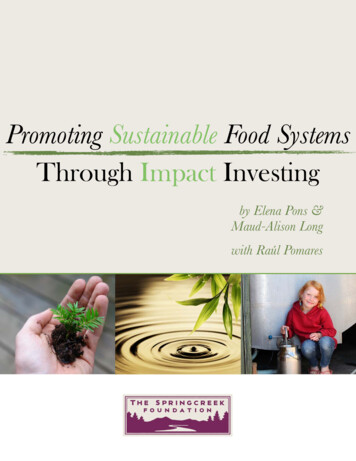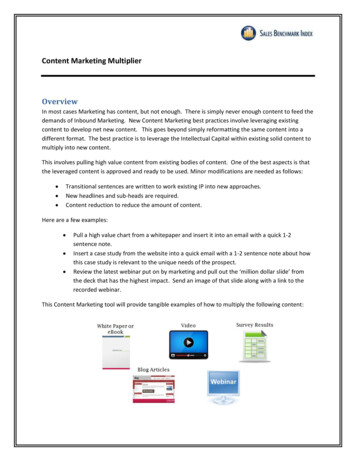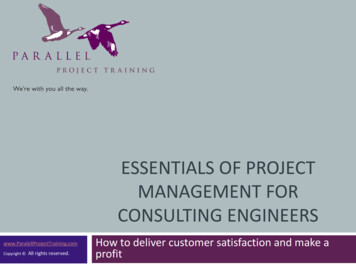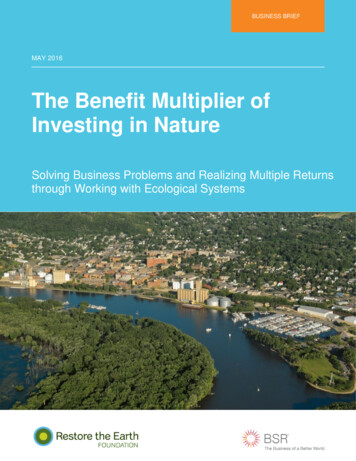
Transcription
BUSINESS BRIEFMAY 2016The Benefit Multiplier ofInvesting in NatureSolving Business Problems and Realizing Multiple Returnsthrough Working with Ecological Systems
BSR The Benefit Multiplier of Investing in Nature1About This Business BriefThe purpose of this business brief is to show that leading companies—around the world and acrosssectors—are citing business reasons for investing in nature-based solutions and the restoration of naturalsystems. The illustrative case examples on the following pages show that early corporate movers are nowengaged with green infrastructure projects as well as ecological restoration initiatives that work withnatural systems and address business issues and challenges, or realize new opportunities. Many of theseearly adopters are finding that natural systems-oriented initiatives are benefit multipliers, which—whendesigned well—make business sense while also offering community and environmental benefits. It is timefor a cohort of fast followers to explore this body of work, and consider crafting business solutions thatwork with, restore, and maintain the natural systems in which companies are literally situated—with thepotential of realizing multiple returns and benefits.The focus of this brief is on corporate initiatives that are conceived of, financially supported by, andimplemented within the company itself—and are not driven by regulation. This brief does not review thebroader public policy context that exists in various countries, such as the United States, which enablesprivate capital investment, including through compliance options. This policy context has been welldocumented in a series of reports and articles by Forest Trends and the Ecosystem Marketplace. Whilewe urge business decision makers to understand and assess real estate and risk-managementopportunities within this public policy- and regulation-enabled context, our focus is on corporate actionsaround the world that are investing in nature-inspired solutions and ecological restoration for statedbusiness reasons—above and beyond regulatory drivers.This business brief draws upon both a review of both NGO and academic literature related to corporateinvestment in ecological restoration, as well as 32 semi-structured interviews conducted in 2015 withthought and practice leaders from the private, public, and non-profit sectors—all of whom work onecological restoration, green infrastructure, and investments in watershed structure and function.Sissel Waage is the lead author of this brief, with key research conducted by Beth Richmond. Any errorsare those of the lead author alone. Please direct comments or questions to Sissel Waage atswaage@bsr.org.ACKNOWLEDGEMENTSThe author wishes to thank the Restore the Earth Foundation for sponsoring this research, and providinginput on various stages of the report. We are also grateful to all interviewees and peer reviewers,including, but not limited to (in alphabetical order): Kit Armstrong, Tundi Agardy, Greg Biddinger, AdamDavis, Willem Ferwerda, Jessica Fox, Varsha Gopalakrishnan, Julie Gorte, Edie Sonne Hall, Frank Hicks,Glen Low, P.J. Marshall, Dave Meyers, David Norriss, Ben Packard, Jessica Davis Pluess, EmiliePrattico, Bert Share, Nina Springer, Ralph Stahl, Peter Stein, Elizabeth Uhlhun, Mike Uhl, Mark Weick,Peter Wheeler, and Steve Zwick.DISCLAIMERBSR publishes occasional papers as a contribution to the understanding of the role of business in societyand trends related to corporate social responsibility and responsible business practices. BSR maintains apolicy of not acting as a representative of its membership, nor does it endorse specific policies orstandards. The views expressed in this publication are those of its authors and do not reflect those ofBSR membersSUGGESTED CITATIONWaage, Sissel. 2016. “The Benefit Multiplier of Investing in Nature: Solving Business Problems andRealizing Multiple Returns through Working with Ecological Systems.” Business Brief. BSR, SanFrancisco, California, USA in collaboration with Restore the Earth Foundation, Ithaca, New York, USA.
BSR The Benefit Multiplier of Investing in Nature2ContentsIntroduction3How Are Companies Starting?6Who Is Investing in What?8What Is the Takeaway?17How Do I Move Forward?18Annexes (separate document)
BSR The Benefit Multiplier of Investing in Nature3IntroductionCompanies are now making investments in natural systems as businesssolutions—to operational challenges, for real estate portfolio optimization,and due to sourcing as well as supply chain management issues. Likeaikido masters, these business leaders have perceived that leverage isgained from working with dynamics that are already underway. Investing innatural systems can also offer benefit multipliers—for companies,ecological systems, and local residents alike. The question increasingly iswhy businesses have not invested in nature-inspired solutions andecological restoration earlier.Nature-based business solutions and investments in ecological restoration can be far lessexpensive than alternatives. What’s more, investments in natural systems-based approachescan be equally effective and also more attractive for local surrounding communities—whileoffering multidimensional returns on investment (ROI). The cases presented in the followingpages illustrate all of these points.For example, Dow now has almost two decades of data from the United States to show howwell a wetland can naturally filter water and improve water quality—at a tiny fraction of the costof a built wastewater-treatment plant. Royal Dutch Shell has come to the same conclusion andis investing in large-scale wetland-based solutions to water management in the Middle East.Coca-Cola has concluded that maintaining a key input to their product (water) requirescorporate investments in reforesting and revegetating lands far upstream from bottling facilities,even though lands are owned by others. Apple sees innovation and leadership opportunities byinvesting in trees and sustainable forest-management approaches that can balance and thusaddress the inputs for packaging. Danone has also been innovating and leading on theincreasingly business-relevant issue of climate change, through trifecta-play investments thatsequester carbon, benefit local people and economies, and introduce greater resilience intonatural systems—within an approach that scales positive impact by enabling other companies toalso invest. Allegheny Power has rationalized its real estate portfolio, while concurrentlymitigating operational risks and realizing significant revenues and tax credits, by asking whatparcels of land could do for the company versus what it could do for the natural environment.The list goes on, as laid out in the following pages and annexes.
BSR The Benefit Multiplier of Investing in Nature4The business cases made to support these investments vary based on the specifics of thesituation. In some companies, such as Dow and Shell, the let’s-work-with-nature approach ismore cost- and operationally effective. End of case. In other companies, the fundamental driversof investments in ecological restoration were the clear dynamics associated with demand andsupply of a key natural resource input—such as watershed-wide, total water demand, andsupply challenges. In other situations, investments make business sense when considered inrelation to a growing set of threat multipliers, such as market demand trends (for timber, amongmany other commodities) or a decrease in reliable, high-quality supplies of essential rawmaterials, particularly when combined with climate change, water stress, and other challengesthat present a growing array of risks to supply chains.In many companies, once nature-based solutions to business issues are identified, then buildinga persuasive final business case is often a mix—as UCLA’s Ed Leamer has asserted isessential for building any business case—of “pictures, words, and numbers, in that order”(though pictures can be graphs representing patterns). The spreadsheets and financialassessment are key—and they should reflect low numbers because investments ininfrastructure are commonly seen as adversely affecting the bottom line, at least in that quarter.However, less widely appreciated in building the business case is the role of visual imagery.These pictures can include actual photographs that people can hold in their minds, or graphsthat illustrate effectiveness of solutions. For Dow, a picture of three bottles of water—showingthe relative viscosity versus clarity of various water-treatment solutions perfectly illustrated theeffectiveness of a substantially cheaper nature-based solution to addressing water qualitychallenges (relative to a traditional waste water treatment plant solution). The business casewas made.Yet, despite the growing set of case examples of nature-inspired and natural-system restorationinitiatives, as laid out in this brief—and the increasing ability of people in companies to build thebusiness case through a combination of pictures, words, and numbers—it is still only a relativelysmall set of companies that are currently investing in nature-based solutions to businesschallenges and ecological restoration opportunities.This relatively slow (though accelerating) uptake to date is not surprising in light of innovationdiffusion theory, stemming from the work of Everett Rogers and others. Based on this research,the rate of innovation diffusion is expected to be a function of the relative advantage of newapproaches, compatibility with existing values and practices, simplicity and ease of use, ease oftesting (“trialability”), and observable results.Investing in nature-based solutions does commonly offer relative advantages, ease of use, andtestability. However, these ecological solutions can be perceived as incompatible with anengineering mindset and expected practices—in which certainty and assurances are thefocus—while also extending beyond the customary training of engineers.In addition, obstacles to nature-based solution uptake exist in terms of internal corporatedynamics. New expenses can be hard to justify within companies, even if they result in longterm savings. Corporate representatives reported, in the interviews conducted for this paper,that experienced business managers are often reluctant to lead nature-based solutions projects,particularly if they lack experience with the issues. Such a project hardly seems like an assuredpath to promotion—just as any new approaches (ones that are untested within a specificcompany) are often skeptically viewed as potential career risks.
BSR The Benefit Multiplier of Investing in Nature5These hurdles make it all the more remarkable that a growing number of corporate innovatorsand early adopters are investing in the (literal) foundations of their business—that is, the veryground on which key business facilities sit, or from which suppliers source inputs.The reported results, though some are preliminary, are often positive and measurable acrossmultiple metrics, including financial, community, and environmental. Illustrations of suchmeasurement approaches have been developed by Restore the Earth Foundation,Commonland, and Dow in collaboration with The Nature Conservancy (TNC) through theEcosystem Services Identification & Inventory, or ESII, among others. These and other suchtools can show how nature-based solutions can offer significant quantitative, benefit-multiplierresults and advantages over alternative approaches.With both a set of case studies and tools, the takeaway for corporate decision makers is tosystematically start asking: Are there opportunities to more efficiently run our business, by working with and gainingleverage from natural systems?Are there natural solutions (in every sense of the word) to business challenges?Can investments in maintaining, restoring, or mimicking nature’s systems create lessexpensive and more effective solutions to business operational problems?Can these investments offer multiple opportunities and upside, in terms of a benefitmultiplier for local residents and regional communities, as well as for natural systems—inaddition to financial return on investment?Our intent is to offer brief case examples, with the goal of inspiring further investigation andadoption of nature-based solutions as well as investment in restoration of nature by businesses.
BSR The Benefit Multiplier of Investing in Nature6How Are Companies Starting?The spark for this new thinking, in many cases, came from the simple act ofpulling up another chair at a brainstorming meeting and inviting a biologist,ecologist, or hydrologist to sit down.Natural scientists often see both the problem and solution spaces from different angles thanothers within companies. Rather than maintaining only a tight focus on facilities and machines,these scientists consider business infrastructure (such as buildings, roads, harbors, or otherbuilt infrastructure) within the natural context in which they are located. They see thesurrounding grasslands, forests, wetlands, and broader watersheds with an analytical lens thatconsiders how species’ composition and distribution may affect the flow and recharge of naturalaquifers, produce oxygen (through plants and trees), sequester carbon, mitigate climatechange, and offer other advantages to people and societies.From an ecologist’s vantage point, the natural environment is not a business limitation. Rather,it is viewed through the same lens that an engineer considers gravity: a reality to consider indesigning a built structure or business approach.Ignore gravity at your own peril. Similarly, ignore natural systems and you may miss a slew ofbusiness solutions while also stumbling on a range of business challenges related to access towater, clean air, climate change, sourcing of raw materials, and many other issues of concern.The natural systems in which business facilities are sited and operate are simply anothersystem companies need to be attuned to—not just for problems, but also for solutions.All businesspeople recognize that they must be attuned to regulatory systems.1 So too shouldcorporate decision makers be tracking and assessing the natural systems in which a companyliterally sits.1It is noteworthy that in some countries there exists supportive public policy and in some cases regulation related to investing inrestoration, as has been well documented in a series of reports and articles by Forest Trends and the Ecosystem Marketplace. Forexample, in the United States, companies can purchase mitigation bank credits to meet compliance needs. If a credit is purchasedfrom an approved restoration project, the permitting time can be significantly decreased, while also addressing issues associatedwith liability for U.S. Clean Water Act-related obligations. For more information, please see the various reports issued by theEcosystem Marketplace.
BSR The Benefit Multiplier of Investing in Nature7For example, prior to siting a new facility—or while managing an existing facility, real estateportfolio, or even supply chain—businesspeople should ask a range of questions, such as: Is this site, and broader region, prone to natural systems-related problems? Thesecould include flooding, storm surges from the ocean, droughts, excessive draw-down ofgroundwater beyond current recharge rates of natural aquifers, water quality problems,or other nature-related issues.Do our corporate siting, facility operations, and supply chain management teamsassess the ecological and hydrological context in which they operate with thesame due diligence that they examine zoning and land use, as well as tax breaks andlabor/employee availability?Does our company assess opportunities to leverage the momentum of naturalsystems to address business challenges or realize new opportunities? Forexample, wetlands can be expanded or created to provide buffers from storms, improvewater filtration, sequester carbon, and create more open space for employees andadjacent communities, as well as habitat for migratory birds and other species.With these kind of questions, new business-relevant insights have come into clear focus for agrowing set of companies.In many cases, these solutions address the fundamental reality that businesses are built on,and within, natural systems. By considering these systems, new opportunities, solutions, andreturns are being generated, as the cases below show.
BSR The Benefit Multiplier of Investing in Nature8Who Is Investing in What?There are four primary business issues that are being addressed through investments in naturebased solutions, as the table below shows:22Business Problem & QuestionBusiness Units InvolvedIllustrative ExamplesHow can we ensure that our companycan maintain access to essential rawmaterials and key inputs?Supply Chain ManagementOperational ManagementAB InBevCoca-ColaIKEAKingfisherHow do we manage our wastewatereffectively and efficiently?Operational ManagementRegulatory ComplianceStakeholder EngagementDowRoyal Dutch ShellHow do we optimize returns on theoverall real estate portfolio?Real Estate PortfolioManagementAllegheny PowerHow do we execute on our corporateenvironmental commitments andpolicy with a focus on sound investmentand strong financial, social, andenvironmental ROI?Corporate StrategyBrandInvestment PortfolioAppleDanoneMarsAdditional cases can be found in the Annexes to this report—which is in a separate document—as well as at the Natural Infrastructurefor Business website and the Natural Capital Business Hub, among a growing set of other related green-infrastructure websites.
BSR The Benefit Multiplier of Investing in Nature9Question: How do we ensure that our company can maintain access toessential raw materials and key inputs?Answer:Invest in the structure and function of the natural systems thatproduce the inputs on which your company relies.For the Coca-Cola Company, ensuring access to water is a corebusiness and multilayered issue—one that includes the legal right todraw water, the maintenance of local community support to use water inthe area, and the actual availability of water to draw. Loss of any one ofthese components can translate into operational disruptions or evencorporate stranded assets.The complexity of these issues came into clear focus in 2004, when the company lost access towater for its Kerala, India, bottling plant and ended up with a stranded asset, disruptedoperations, and a tarnished reputation.Both in response and looking forward, The Coca-Cola Company crafted a multidimensionalcorporate water stewardship plan. Their approach was far more diversified than a buy-morewater-rights approach. Rather, the company focused not just on efficient water use within theirown facilities, but also on overall water availability in the watersheds on which they relied—factoring in the demand for water by all water users within the context of total water supply. Inwatersheds and basins with water challenges and risks, the company looked to nature-basedsolutions for investments that would improve supply through improved watershed structure andfunction.Notably, the plan called for investments on lands that were not owned by the company itself. Assuch, Coca-Cola was looking beyond its own corporate fence-lines to improve upstreamwatershed structure and function, as well as overall aquifer recharge and water access for all inthe area.Overall, the company’s goal to be water neutral by 2020 has included significant investments inwatershed restoration and protection initiatives, and was launched in collaboration with a rangeof organizations.For example, in California’s Sierra Nevada mountains, Coca-Cola has given about US 200,000for watershed restoration in the Indian Valley, the headwaters of the Mokelumne River thatsupplies water to Coca-Cola’s bottling plant in San Leandro. In partnership with several otherorganizations, the money has been used to create natural “soil plugs” within upland streams, inorder to have the water pool up in the meadows. This basic restoration investment allows themeadow to hold water, which in turn enables water to soak into underground aquifers while alsonourishing native plants and habitat. Such efforts improve overall water availability for allusers—both residential and industrial—while concurrently contributing to the company’s licenseto operate through investing in solutions to overall water problems in the area.
BSR The Benefit Multiplier of Investing in Nature10This systemic approach to solving problems at the source is the business rationale thatunderlies the company’s US 1 billion investment in 382 water-related projects at facilitiesaround the world as part of its “water replenishment” strategy. The wide range of projects thatCoca-Cola has funded reflects a nuanced understanding of how water cycles through differentecological systems, such as: In Texas, Coca-Cola has invested in removing non-native plants and planting nativegrasses to restore grasslands in the Brazos and Trinity Rivers regions, which in turnincreases water quality and quantity to municipal water supplies for Dallas, Fort Worth,and Waco, Texas.In Michigan, the company is supporting farmer adoption of new practices, such as onfarm wetland restoration, low- or no-tillage agricultural practices, sustainable cornproduction, and removal of invasive species—all of which aim to increase infiltrationof water into the watershed and improve the water quality of the Paw Paw River.In Georgia, Coca-Cola is collaborating with organizations to encourage farmer adoptionof remote soil-moisture monitoring and precision irrigation management to savewater by irrigating only when needed, which has saved about 154 million liters of waterper year over 1,000 acres.The full list of projects and on-the-ground partners is much longer, and offers the clear messagethat Coca-Cola sees investing in nature as an important element of its business and to retainingaccess to key inputs.Anheuser-Busch InBev (AB InBev) has arrived at a similarconclusion as Coca-Cola about the importance of well-functioningwatersheds and the natural systems from which they draw water.Therefore, AB InBev has committed to “engage in watershedprotection measures in partnership with local stakeholders” at 100percent of its facilities located in key areas in Argentina, Bolivia,Brazil, China, Mexico, Peru, and the United States. This corporatecommitment is translating into on-the-ground action.For example, AB InBev partnered with the World Wildlife Fund, local communities andgovernments in the Corumbá-Paranoá Basin, which provides the water used by the company’sBrasilia brewery. Among the activities included in the initiative is the planting of 5,700 saplingsin the region.In addition, AB InBev is working in the Jaguariúna region of Brazil, in collaboration with TheNature Conservancy (TNC), which provides a portion of the water to the greater São Pauloregion as well as the company’s beverage facility. Just as in the other Brazilian basins, work isunderway on identifying the most important areas in which to restore ecological systems toimprove natural water systems, particularly the filtration of water into natural aquifers, whichrecharges groundwater systems, in term improving local water supply. Of course, given ABInBev’s bottling plant in the region, this water supply is also a core business issue and essentialto the plant staying operational.
BSR The Benefit Multiplier of Investing in Nature11Companies beyond the beverage industry are also investing inthe natural systems that produce key business inputs. Forexample, Kingfisher—the largest home-improvement retailer inEurope—is working toward global net reforestation. Thecompany states: “We aim to protect forests and our timbersupplies by taking a restorative approach, creating more forest than we use.” Therefore,Kingfisher has launched projects in China, the U.K., Poland and Spain to “improve forestmanagement, benefit biodiversity, and get local communities involved.”The company’s timber demand for the goods that it sells means that investing in wood supplyflow will mitigate against decreasing supply amidst growing overall demand and rising timberprices. The company expects these actions to translate into financial savings for Kingfisher,which the Boston Consulting Group estimates to be between 45 to 60 million (US 64 toUS 85 million) per year.Kingfisher’s CEO is clear on the rationale for these actions, stating: “This is revenue-generatingfor us and we shouldn’t be shy about saying that. We have to make a business case for it.” In areport on their “net-positive impact” work, Kingfisher lays out the business case for thisreforestation work and other efforts as:“Net Positive means not just preventing deforestation, but working towards netreforestation. It means helping create homes that go beyond zero carbon to becomegenerators of their own energy. It means innovating new business models, products, andservices that are net-positive by design. Net Positive will be good for our business. Itwill enable us to secure the resources that we use, unlock new opportunities, and todrive growth. Today, the system is broken: The use of resources worldwide isoutstripping supply.”Overall, these commitments are about sourcing and supply chain management over time, aswell as maintaining brand and reputation as a company that takes seriously stakeholder (and,increasingly, investor) concerns about deforestation, and also the linkages between cuttingdown forests and releasing carbon that drives climate change.The key to the long-term success of these goals will be not only maintaining overall forest cover,but also ensuring that those forests maintain biodiversity and ecological structures that enablethe ongoing flow of various ecosystem services from which local communities derive benefit.Also relying on wood for its business, IKEA has committed tobeing “Forest Positive” by August 2020, meaning that thecompany “will have continued full compliance with our forestryrequirements and promote the adoption of sustainable forestrymethods beyond our own needs and across the industry.” Thiswork, the company asserts, will also contribute to ending deforestation.To support these commitments, IKEA has put in place supply chain standards and managementpractices that track where raw materials come from, as well as whether these lands aremanaged sustainably, with plans for continual regeneration of trees and forests. In addition, thecompany is working with the World Wildlife Fund, the Forest Stewardship Council, as well asother companies to improve methods to credibly provide deforestation-free assurances withintheir supply chains. As with Kingfisher, long-term success will hinge on the ability to factor in notjust tree-cover, but also issues related to biodiversity, ecosystem services flows, and communityconcerns, such as those laid out by the Climate, Community, and Biodiversity Alliance (CCBA).
BSR The Benefit Multiplier of Investing in Nature12As with Kingfisher, IKEA’s investments in wood are ultimately about forward-looking supplychain management as well as reputation and brand management. Together, these supply andreputational issues form the basis for a compelling business case in a world in whichstakeholders are increasingly concerned about whether companies’ supply chain practices aredriving deforestation and, in the process, contributing to the dynamics of climate change.For example, the Carbon Disclosure Project (CDP) urges corporate disclosure on forest-relatedrisks and has been tracking corporate commitments to deforestation-free supply chains. Inaddition, Forest Trends has collaborated with other organizations—including CDP and WWF—on “supply change” analyses that examine whether companies are realizing commitments toaddress deforestation in supply chains. Looking at key drivers of deforestation, as laid out in aWRI and by WWF, there is an immense opportunity for companies in other sectors, notablywithin the food and agriculture industry, to continue to make commitments to deforestation-freesupply chains.Question: How do we manage our wastewater efficiently?Answer:Invest in a natural approach to filtering water.To meet regulated wastewater quality mandates in a Texasfacility, Dow had to take action. Rather than building a US 40million wastewater treatment plant, the company spent US 1million to create a wetland that naturally filters water—withsignificantly lower construction and operational costs, asdocumented in a peer reviewed article. Not only did thisapproach save US 39 million dollars, but it has been effective.Since the day that water first flowed through the created wetland about 19 years ago, thisapproach to water filtration has been in regulatory compliance with U.S. water requirements.In addition, over almost two decades, the wetland-based water filtration approach has deliveredUS 282 million in net present value savings, with more savings to come in the future as itcontinues to function well.Dow’s investment in “engineered natural treatment systems for industrial wastewater” isessentially a human-constructed wetland to undertake the water-filtration processes that naturalwetlands do very well. The final results look strikingly similar being out in nature, because it iscreated to enable natural ecological systems to do what they do—as shown in a video createdby Dow.The advantages of this approach, when compared with a built wastewater-treatment plant, arenumerous and are described in a TNC case study as including: Capital expense savings, with US 1.2-1.4 million versus US 40 million for the grayinfrastructure alternative proposed
BSR The Benefit Multiplier of Investing in Nature 13Operating expense savings, with no energy, additives, or oxygen; no bio-solidsdisposal; minimal maintenanceLower environmental footpr
BSR The Benefit Multiplier of Investing in Nature 4 The business cases made to support these investments vary based on the specifics of the situation. In some companies, such as Dow and Shell, the let's-work-with-nature approach is more cost- and operationally effective. End of case. In other companies, the fundamental drivers




